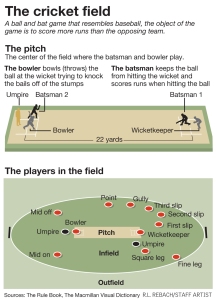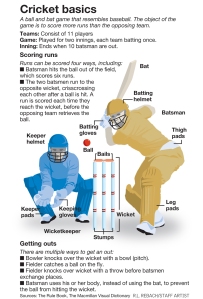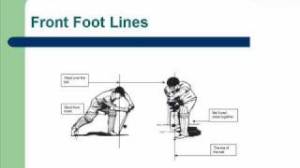Cricket Rules |
By  |
The rules and regulations of cricket are a set of guidelines established by the Marylebone Cricket Team (MCC) which explain the laws and guidelines of cricket globally, to ensure consistency and equity. There are currently 42 laws and guidelines, which summarize all aspects of how the overall activity is performed from how a team benefits an activity title, how a batsman is ignored, through to requirements on how the message is to be prepared and managed. The MCC is a private club based in London in Britain and is no longer the mission’s formal guiding body; however the MCC maintains the trademark in the laws and guidelines of the overall activity and only the MCC may change the laws and guidelines, although these days this would usually only be done after conversations with the mission’s global guiding system the Worldwide Cricket Authorities (ICC).
Cricket is one of the few sports for which the guiding concepts are referred to as Laws rather than as Rule or Regulations. However guidelines to supplement and or differ the laws and guidelines may be decided for particular challenges.

Players
A cricket team includes 11 players, along with a leader or captain. Outside of formal format, teams can play with more than eleven-a-side, though no more than 11 players may field.
Substitutes
In cricket, a substitute player can be introduced on for an injured fielder. However, a substitute should not bat, bowl, keep wicket or act as captain. The player who was injured can come back if he has recovered.
The umpires
There are two umpires, who apply the Laws, make all necessary decisions, and relay the decisions to the scorers. While not required under the laws of cricket, in higher level cricket a third umpire (located off the ground and available to assist the on-field umpires) may be used under the specific playing conditions of a particular match or tournament.
The scorers
There are two scorers who respond to the umpires’ signals and keep the score.

Ball
A cricket ball is between 8 1316 and 9 inches (22.4 cm and 22.9 cm) in circumference, and weighs between 5.5 and 5.75 ounces (155.9g and 163g). Only one ball is used at a time, unless it is lost, when it is replaced with a ball of similar wear. It is also replaced at the start of each innings, and may, at the request of the fielding side, be replaced with a new ball, after a certain number of overs have been bowled (80 in Test matches, 34 in ODIs). The gradual degradation of the ball through the innings is an important aspect of the game.
Bat
The bat is no more than 38 inches (97 cm) in length, and no more than 4.25 inches (10.8 cm) wide. The hand or glove holding the bat is considered part of the bat. Ever since the Heavy Metal incident, a highly publicized marketing attempt by Dennis Lillee, who brought out an aluminum bat during an international game, the laws have provided that the blade of the bat must be made of wood (and in practice, they are made from White Willow wood).
Pitch
 The pitch is a rectangular area of the ground 22 yards (20 m) long and 10 ft (3.0 m) wide. The Ground Authority selects and prepares the pitch, but once the game has started, the umpire’s control what happens to the pitch. The umpires are also the arbiters of whether the pitch is fit for play, and if they deem it unfit, with the consent of both captains can change the pitch. Professional cricket is almost always played on a grass surface. However, in the event a non-turf pitch is used, the artificial surface must have a minimum length of 58 ft (18 m) and a minimum width of 6 ft (1.8 m).
The pitch is a rectangular area of the ground 22 yards (20 m) long and 10 ft (3.0 m) wide. The Ground Authority selects and prepares the pitch, but once the game has started, the umpire’s control what happens to the pitch. The umpires are also the arbiters of whether the pitch is fit for play, and if they deem it unfit, with the consent of both captains can change the pitch. Professional cricket is almost always played on a grass surface. However, in the event a non-turf pitch is used, the artificial surface must have a minimum length of 58 ft (18 m) and a minimum width of 6 ft (1.8 m).
Wickets
The wicket consists of three wooden stumps that are 28 inches (71 cm) tall. The stumps are placed along the batting crease with equal distances between each stump. They are positioned so they are 9 inches (23 cm) wide. Two wooden bails are placed on top of the stumps. The bails must not project more than 0.5 inches (1.3 cm) above the stumps, and must, for men’s cricket, be 4+5⁄16 inches (10.95 cm) long. There are also specified lengths for the barrel and spigots of the bail. There are different specifications for the wickets and bails for junior cricket. The umpires may dispense with the bails if conditions are unfit (i.e. it is windy so they might fall off by themselves). Further details on the specifications of the wickets are contained in Appendix A to the laws.
Bowling, Popping & Return creases
This law sets out the dimensions and locations of the creases. The bowling crease, which is the line the stumps are in the middle of, is drawn at each end of the pitch so that the three stumps in the set of stumps at that end of the pitch fall on it (and consequently it is perpendicular to the imaginary line joining the centres of both middle stumps). Each bowling crease should be 8 feet 8 inches (2.64 m) in length, centered on the middle stump at each end, and each bowling crease terminates at one of the return creases. The popping crease, which determines whether a batsman is in his ground or not, and which is used in determining front-foot no balls (see law 24), is drawn at each end of the pitch in front of each of the two sets of stumps. The popping crease must be 4 feet (1.2 m) in front of and parallel to the bowling crease. Although it is considered to have unlimited length, the popping crease must be marked to at least 6 feet (1.8 m) on either side of the imaginary line joining the centre’s of the middle stumps. The return creases, which are the lines a bowler must be within when making a delivery, are drawn on each side of each set of the stumps, along each sides of the pitch (so there are four return creases in all, one on either side of both sets of stumps). The return creases lie perpendicular to the popping crease and the bowling crease, 4 feet 4 inches (1.32 m) either side of and parallel to the imaginary line joining the centre’s of the two middle stumps. Each return crease terminates at one end at the popping crease but the other end is considered to be unlimited in length and must be marked to a minimum of 8 feet (2.4 m) from the popping crease.
Covering the pitch
 The pitch is said to be covered when the grounds men have placed covers on it to protect it against rain or dew. The laws stipulate that the regulations on covering the pitch shall be agreed by both captains in advance. The decision concerning whether to cover the pitch greatly affects how the ball will react to the pitch surface, as a ball bounces differently on wet ground as compared to dry ground. The area beyond the pitch where a bowler runs so as to deliver the ball (the ‘run-up’) should ideally be kept dry so as to avoid injury through slipping and falling, and the Laws also require these to be covered wherever possible when there is wet weather.
The pitch is said to be covered when the grounds men have placed covers on it to protect it against rain or dew. The laws stipulate that the regulations on covering the pitch shall be agreed by both captains in advance. The decision concerning whether to cover the pitch greatly affects how the ball will react to the pitch surface, as a ball bounces differently on wet ground as compared to dry ground. The area beyond the pitch where a bowler runs so as to deliver the ball (the ‘run-up’) should ideally be kept dry so as to avoid injury through slipping and falling, and the Laws also require these to be covered wherever possible when there is wet weather.
Scoring runs
Runs are scored when the two batsmen run to each other’s end of the pitch. Several runs can be scored from one ball.
Boundaries
A boundary is marked round the edge of the field of play. If the ball is hit into or past this boundary, four runs are scored, or six runs if the ball didn’t hit the ground before crossing the boundary.
Lost ball
If a ball in play is lost or cannot be recovered, the fielding side can call “lost ball”. The batting side keeps any penalty runs (such as no-balls and wides) and scores the higher of six runs and the number of runs actually run.
The result
The side which scores the most runs wins the match. If both sides score the same number of runs, the match is tied. However, the match may run out of time before the innings have all been completed. In this case, the match is drawn.
The over
An over consists of six balls bowled, excluding wides and no balls. Consecutive overs are delivered from opposite ends of the pitch. A bowler may not bowl two consecutive overs.
Dead ball
 The ball comes into play when the bowler begins his run up, and becomes dead when all the action from that ball is over. Once the ball is dead, no runs can be scored and no batsmen can be dismissed. The ball becomes dead for a number of reasons, most commonly when a batsman is dismissed, when a boundary is hit, or when the ball has finally settled with the bowler or wicketkeeper.
The ball comes into play when the bowler begins his run up, and becomes dead when all the action from that ball is over. Once the ball is dead, no runs can be scored and no batsmen can be dismissed. The ball becomes dead for a number of reasons, most commonly when a batsman is dismissed, when a boundary is hit, or when the ball has finally settled with the bowler or wicketkeeper.
No ball
A ball can be a no ball for several reasons: if the bowler bowls from the wrong place; or if he straightens his elbow during the delivery; or if the bowling is dangerous; or if the ball bounces more than twice or rolls along the ground before reaching the batsman; or if the fielders are standing in illegal places. A no ball adds one run to the batting team’s score, in addition to any other runs which are scored off it, and the batsman can’t be dismissed off a no ball except by being run out, or by handling the ball, hitting the ball twice, or obstructing the field.
Wide ball
An umpire calls a ball “wide” if, in his or her opinion, the batsman did not have a reasonable opportunity to score off the ball. A ball is called wide when the bowler bowls a bouncer that goes over the head of the batsman. A wide adds one run to the batting team’s score, in addition to any other runs which are scored off it, and the batsman can’t be dismissed off a wide except by being run out or stumped, or by handling the ball, hitting his wicket, or obstructing the field.
Bye and Leg bye
If a ball that is not a no ball or wide passes the striker and runs are scored, they are called byes. If a ball that is not a no ball hits the striker but not the bat and runs is scored, they are called leg-byes. However, leg-byes cannot be scored if the striker is neither attempting a stroke nor trying to avoid being hit. Byes and leg-byes are credited to the teams but not the batsman’s total.

Bowled
A batsman is out if his wicket is put down by a ball delivered by the bowler. It is irrelevant whether the ball has touched the bat, glove, or any part of the batsman before going on to put down the wicket, though it may not touch another player or an umpire before doing so.
Timed out
An incoming batsman must be ready to face a ball (or be at the crease with his partner ready to face a ball) within 3 minutes of the outgoing batsman being dismissed, otherwise the incoming batsman will be out.
Caught
If a ball hits the bat or the hand holding the bat and is then caught by the opposition within the field of play before the ball bounces, then the batsman is out.
Handled the ball
If a batsman willfully handles the ball with a hand that is not touching the bat without the consent of the opposition, he is out.
Hit the ball twice
If a batsman hits the ball twice, other than for the sole purpose of protecting his wicket or with the consent of the opposition, he is out.
Hit wicket
If, after the bowler has entered his delivery stride and while the ball is in play, a batsman puts his wicket down by his bat or his body he is out. The striker is also out hit wicket if he puts his wicket down by his bat or his body in setting off for a first run. “Body” includes the clothes and equipment of the batsman.
Leg before wicket (LBW)
If the ball hits the batsman without first hitting the bat, but would have hit the wicket if the batsman was not there, and the ball does not pitch on the leg side of the wicket, the batsman will be out. However, if the ball strikes the batsman outside the line of the off-stump, and the batsman was attempting to play a stroke, he is not out.
Obstructing the field
If a batsman willfully obstructs the opposition by word or action, he is out.
Run out
A batsman is out if at any time while the ball is in play no part of his bat or person is grounded behind the popping crease and his wicket is fairly put down by the opposing side.
Stumped
A batsman is out when the wicket-keeper (see Law 40) puts down the wicket, while the batsman is out of his crease and not attempting a run.
